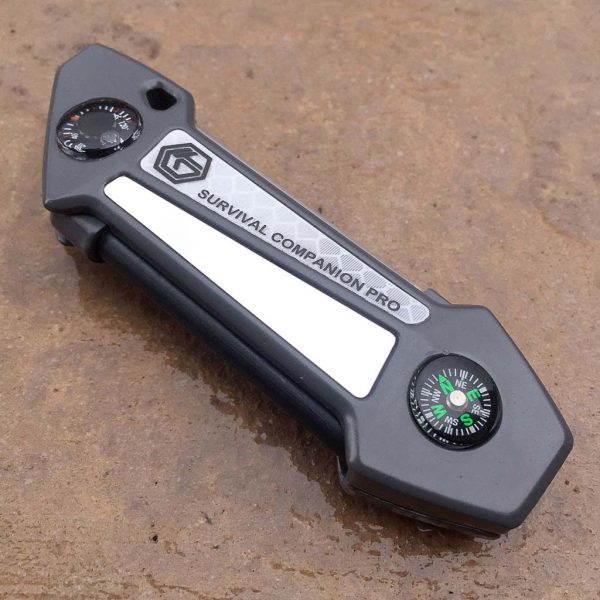
I’m a big fan of gadgets that pack several (or many) uses into a single, small device. And with survival products being a huge market these days, when I saw the Off Grid Tools Survival Companion Pro multitool, I was immediately interested. It’s the size of a largish pocket knife, but includes 21 survival-type tools—such as fire-starting rods, a compass and signal mirror, to name but a few—in a durable frame aluminum frame. Let’s check it out! Gadget on!
What is it?
The Off Grid Tools Survival Companion Pro is a unique multitool that includes 21 features that outdoor enthusiasts, military, rescue/first responders, preppers or just about anyone might find useful in survival situations.
Hardware specs
- Product Dimensions & Weight: 4.50 x 1.40 x 0.66 inches ; 0.27 pounds
- Body: Dark gray die-cast aluminum
- Fold-out ferrocerium fire starter rod and magnesium tinder rod
- Carbide blade/axe sharpener
- Fail-safe whistle, 109dB max volume
- Liquid-filled compass
- Thermometer
- Reflective panel
- Signal mirror panel
- Lanyard hole
- Feature-rich removable stainless steel belt clip, including:
- Can opener
- Bottle opener
- Flat head screwdriver
- Serrated saw edge
- 1.5-inch ruler
- Fire starter scraper
- Hex wrenches in 1/4″, 5/16″, 3/8″, 7/16″ sizes
- Designed in the USA, manufactured in China
- Limited Warranty
What’s in the box?
- Off Grid Tools Survival Companion Pro

The Survival Companion Pro’s packaging, as shown in the images above and below, gives good visibility to the product contained inside, which is a feature I really appreciate in retail product packaging.

The back of the package also includes a list of the Survival Companion Pro’s many features.
Design and features

I don’t think it’s an exaggeration to state that the Survival Companion Pro is veritably packed with features (21 in total), which I could tell even before I removed it from the package.
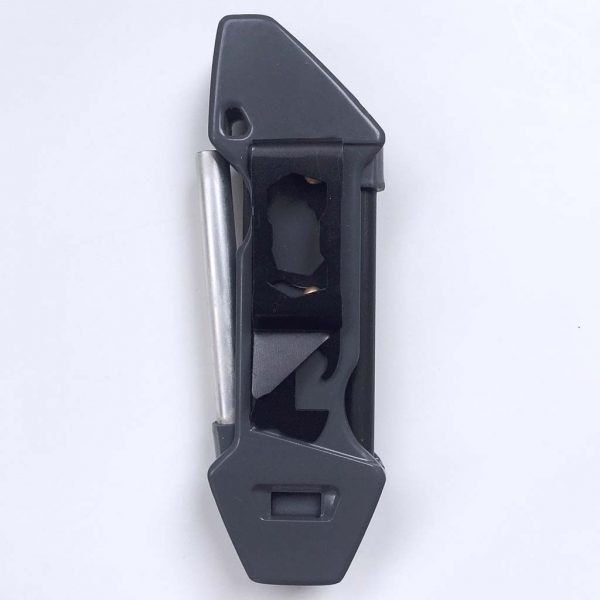
Once out of the package, the Survival Companion Pro felt quite solid in my hand, which I took to be an early indicator of high-quality design, build and materials.

The Survival Companion Pro’s main body is made from durable aluminum that should have a low potential for rust or other corrosion, yet is lightweight and strong. It also has a robust pocket clip.
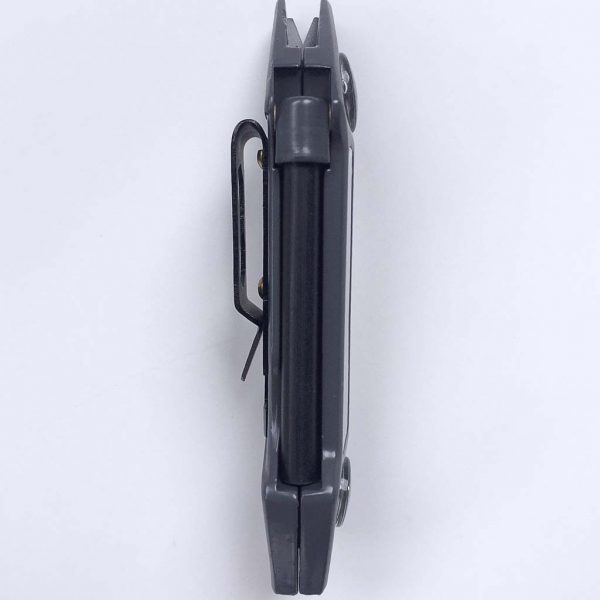

Although it is not actually a pocket knife, the Survival Companion Pro is actually more like a multitool, with its fold-out magnesium tinder rod and ferrocerium fire-starting rod, both of which are shown above in their fully-deployed positions. Magnesium is a material that can be scraped to produce fine shavings that can be used as fuel to start a fire in the absence of other tinder-type materials. Ferrocerium is a metallic alloy material that can be scraped to produce sparks which have enough heat to ignite the fine magnesium shavings. Once a bit of magnesium shavings have been produced by scraping the rod, the ferrocerium rod can be scraped quickly to produce sparks which have enough heat to ignite the magnesium shavings. Therefore, using these two fold-out rods, the Survival Companion Pro can be used to create a small fire, which can then be fueled, stoked and tended to create a large fire should the need ever arise. Also note that the Survival Companion Pro’s belt clip (described in detail below) can be removed and used as a scraper for both the ferrocerium and magnesium rods.

Another feature of the Survival Companion Pro is its “fail-safe, pealess” whistle, depicted above. Off Grid Tools claims that this whistle has a 109dB max volume. I did a bit of research and Purdue University reports that 109dB is approximately the volume of a steel mill auto horn at a distance of 1 meter. That is LOUD, people. Loud enough to possibly get the attention of a first responder or rescuer some distance away from your position in an emergency.

As mentioned above, although the Survival Companion Pro is not a pocket knife, it does have a carbide blade sharpener, as seen in the image above. A good knife is a survival essential, but a dull knife will be much less useful, so this sharpener feature could come in very handy. It could even be used on a small axe in a pinch.

Survival Companion Pro’s belt clip itself also contains several very useful features. The belt clip typically sits securely attached to the back of the Survival Companion Pro’s main body by two brass pins, as seen above.

The belt clip can be removed for use. I found the easiest way was to start by rotating its right side upward to release it from the right-side pin, then wiggling the clip a bit to free it from the left-side pin.

It only took me a couple of times before I had this maneuver down and it became simple to remove the belt clip for quick operation and then to replace it securely when finished.

The belt clip has a spring-type design that allows it to be used to attach the Survival Companion Pro to not only a belt, but also a pocket, backpack webbing, straps, or many other locations.

As listed in the Hardware specs section above, the belt clip contains, starting from the left in the image above, a scraper for the ferrocerium and magnesium firestarter rods (described above), flat head screwdriver (can also possibly be used as a Phillips head in a pinch) can opener, bottle opener, serrated saw edge, 1.5-inch ruler, a, and hex wrenches in 1/4″, 5/16″, 3/8″, 7/16″ sizes. That’s a lot of tools packed into a pocket clip!

Back to the Survival Companion Pro’s main body, another useful feature is a small thermometer, shown in the images above and below. Note that also show above is the lanyard hole on the left side. I found this lanyard hole to be the only somewhat frustrating feature because it was challenging to get anything through there. I tried a small S-carabiner and it wouldn’t fit, and also some 550 paracord, but it didn’t seem to want to be pushed through the hole very easily.
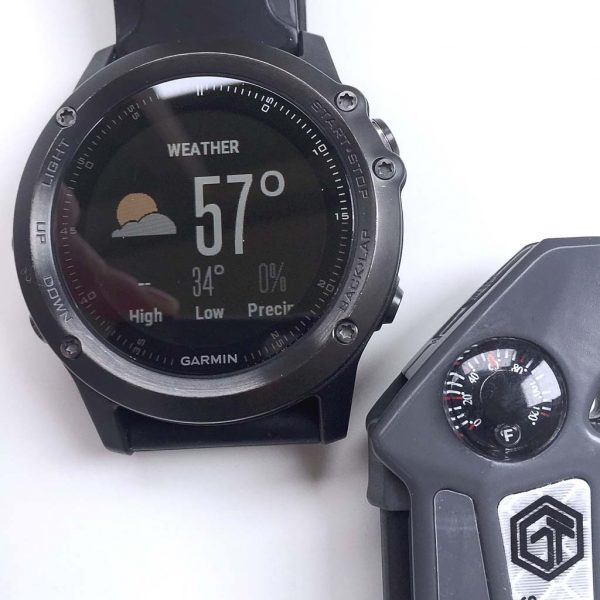
I compared the accuracy of the Survival Companion Pro’s thermometer to the weather app connected to my Garmin Fenix 3 HR watch. Both seemed to be comparable within a few degrees of each other.
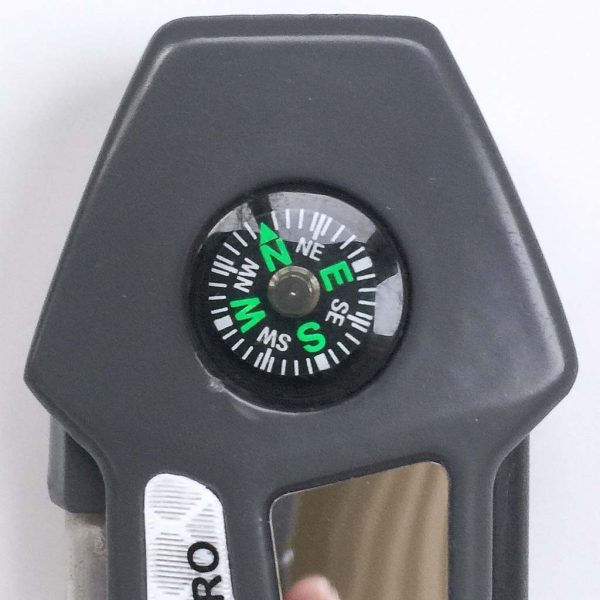
Another of the Survival Companion Pro’s move essential survival features is a small, liquid-filled compass, as shown above and below.

Once again, I used my Garmin Fenix 3 HR watch—this time its compass app—to compare to the Survival Companion Pro’s thermometer, and once again, they only seemed to differ by a few degrees. While this variance could make a difference for accurate navigation in a survival situation, I’m not sure I fully trust my Fenix 3 HR’s compass app’s accuracy. I may have to do a bit more experimenting and report back here at a later date.

Two more features are packed into the main body of the Survival Companion Pro, as shown in the images above and below. First, a reflective strip that could be used in low-light situations.
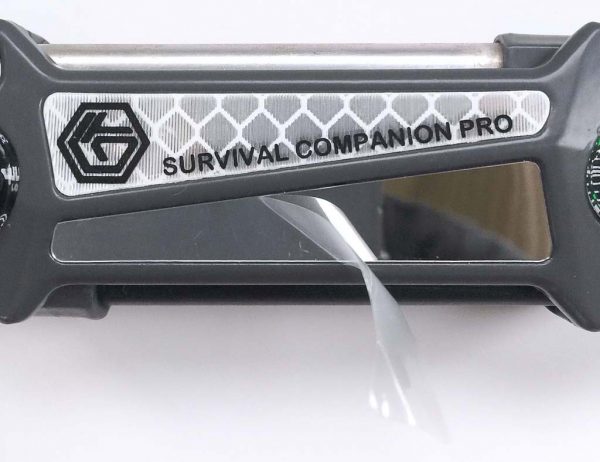
Additionally, below the reflective strip is a mirror-like reflector panel, as shown in the images above and below. At first, I didn’t realize that this reflector panel had a thin protective film over it (see above).

However, once I removed the film, this panel proved to be quite reflective, mirror finish, a feature that could be used to signal far-away rescuers by reflecting the sun’s rays.
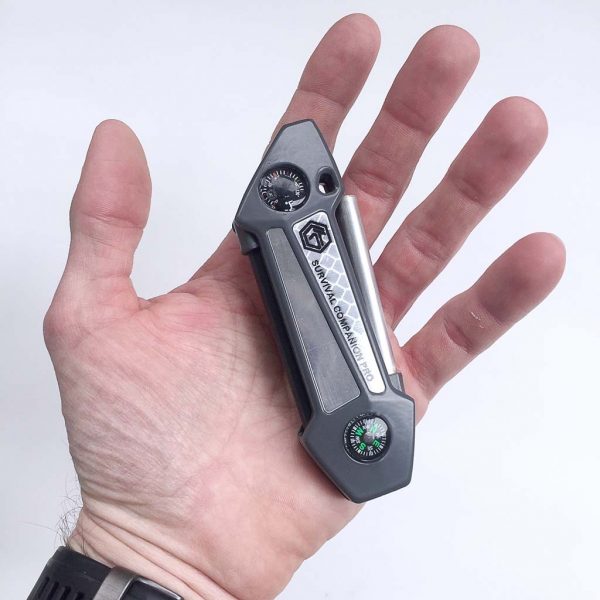
The Survival Companion Pro is roughly the size of a large folding-blade pocket knife, easily fitting into the palm of my hand. The entire device is stout, sturdy and compact, yet lightweight.
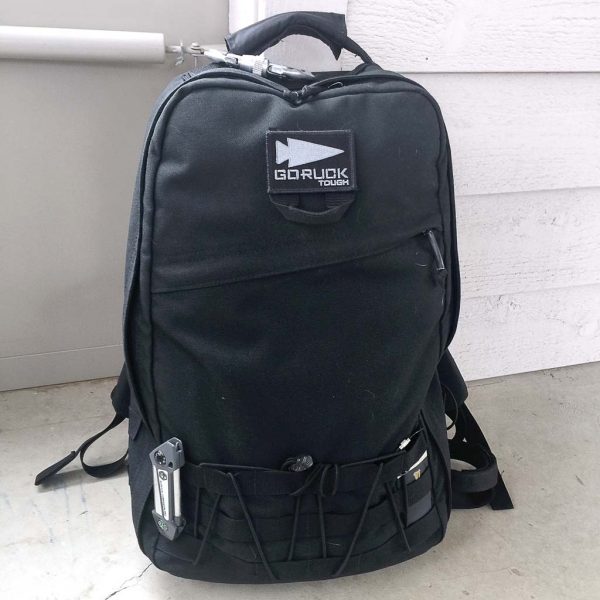
During my evaluation period, I carried the Survival Companion Pro attached to the MOLLE webbing on the exterior of my GORUCK GR1 rucksack, as seen in the images above and below.
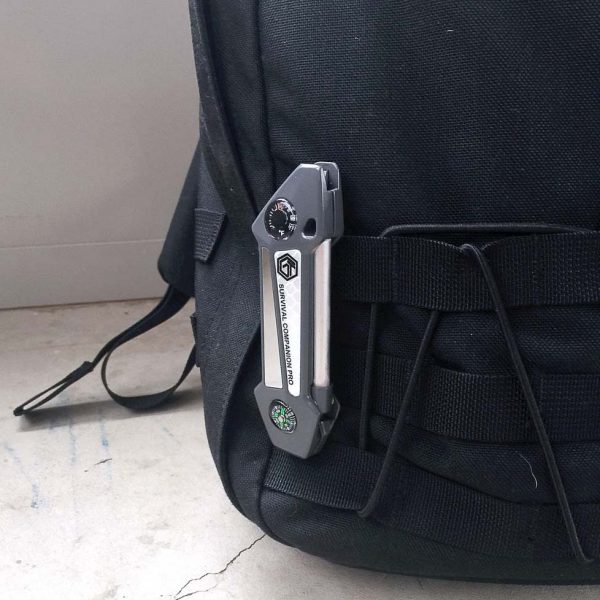
The Survival Companion Pro’s spring-type belt clip worked, keeping the tool attached very securely.

What I like
- Lots of survival tools packed into a small and compact size and shape
- Durable
- Inexpensive
What needs to be improved
- Lanyard hole could be a bit larger
- Thermometer and compass may not be super accurate, but they do the job
Final thoughts
The Off Grid Tools Survival Companion Pro is packed with useful features in a small size. You may never need to use this product in a survival situation, but in an emergency, it might come in very handy and could possibly even save your life. I carried the Survival Companion Pro as part of my EDC during the time that I evaluated it, and I have since made it a part of my ongoing EDC kit. Although I thankfully never actually needed it in an emergency or survival situation, it gave me the confidence to know that I had its many useful features available for quick access should the need arise. Plus, with its relatively low price, you could buy one of each of your vehicles, give them out as gifts and so forth without breaking the bank. If you are into EDC and/or survival tools, have a look at the Off Grid Tools Survival Companion Pro.
Update 5/24/20
Although I haven’t had an occasion to use this product, it is still in my survival kit in my car for emergencies.
Price: $24.99
Where to Buy: Off Grid Tools or Amazon
Source: The sample of this product was provided by Off Grid Tools.

Gadgeteer Comment Policy - Please read before commenting
Based on the features of your watch, I suspect that it is set to use geographic north (the North Pole), and the compass is using, obviously, magnetic north. If you are located somewhere in the western US, 13 degrees of declination is very reasonable. Actually, I just looked it up, and in San Jose, CA (where I live) the magnetic declination is 13 degrees and change.
Or the survival compass may just suck–always good to verify things like that.
You need a good compass for precision navigation. Those can be had for <$20. This gadget's compass would be useful for setting you in the right general direction and will prevent you from walking in circles (a real danger when one is lost n the forest).
I just bought mine from the Duluth Trading Co. Looking forward to using it. The compass is accurate for Magnetic north.
Thanks for the feedback, Glenn! I’d be curious to know how you like it, once you have received it and had a chance to check it out a bit!